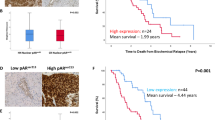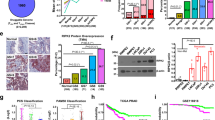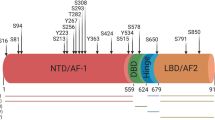Abstract
Prostate cancer remains a leading cause of cancer-related mortality worldwide owing to our inability to treat effectively castration-resistant tumors. To understand the signaling mechanisms sustaining castration-resistant growth, we implemented a mass spectrometry-based quantitative proteomic approach and use it to compare protein phosphorylation in orthotopic xenograft tumors grown in either intact or castrated mice. This investigation identified changes in phosphorylation of signaling proteins such as MEK, LYN, PRAS40, YAP1 and PAK2, indicating the concomitant activation of several oncogenic pathways in castration-resistant tumors, a notion that was confirmed by tumor transcriptome analysis. Further analysis demonstrated that the activation of mTORC1, PAK2 and the increased levels of YAP1 in castration-resistant tumors can be explained by the loss of androgen inhibitory actions. The analysis of clinical samples demonstrated elevated levels of PAK2 and YAP1 in castration-resistant tumors, whereas knockdown experiments in androgen-independent cells demonstrated that both YAP1 and PAK2 regulate cell colony formation and cell invasion activity. PAK2 also influenced cell proliferation and mitotic timing. Interestingly, these phenotypic changes occur in the absence of obvious alterations in the activity of AKT, MAPK or mTORC1 pathways, suggesting that PAK2 and YAP1 may represent novel targets for the treatment of castration-resistant prostate cancer. Pharmacologic inhibitors of PAK2 (PF-3758309) and YAP1 (Verteporfin) were able to inhibit the growth of androgen-independent PC3 xenografts. This work demonstrates the power of applying high-resolution mass spectrometry in the proteomic profiling of tumors grown in vivo for the identification of novel and clinically relevant regulatory proteins.
This is a preview of subscription content, access via your institution
Access options
Subscribe to this journal
Receive 50 print issues and online access
$259.00 per year
only $5.18 per issue
Buy this article
- Purchase on Springer Link
- Instant access to full article PDF
Prices may be subject to local taxes which are calculated during checkout







Similar content being viewed by others
Accession codes
References
Schroder FH, Hugosson J, Roobol MJ, Tammela TL, Ciatto S, Nelen V et al. Screening and prostate-cancer mortality in a randomized European study. N Engl J Med 2009; 360: 1320–1328.
Crawford ED . Understanding the epidemiology, natural history, and key pathways involved in prostate cancer. Urology 2009; 73 (Suppl): S4–S10.
Taylor BS, Schultz N, Hieronymus H, Gopalan A, Xiao Y, Carver BS et al. Integrative genomic profiling of human prostate cancer. Cancer Cell 2010; 18: 11–22.
Grasso CS, Wu YM, Robinson DR, Cao X, Dhanasekaran SM, Khan AP et al. The mutational landscape of lethal castration-resistant prostate cancer. Nature 2012; 487: 239–243.
Visakorpi T, Hyytinen E, Koivisto P, Tanner M, Keinanen R, Palmberg C et al. In vivo amplification of the androgen receptor gene and progression of human prostate cancer. Nat Genet 1995; 9: 401–406.
Sato K, Qian J, Slezak JM, Lieber MM, Bostwick DG, Bergstralh EJ et al. Clinical significance of alterations of chromosome 8 in high-grade, advanced, nonmetastatic prostate carcinoma. J Natl Cancer Inst 1999; 91: 1574–1580.
Saramaki O, Visakorpi T . Chromosomal aberrations in prostate cancer. Front Biosci 2007; 12: 3287–3301.
Mulholland DJ, Tran LM, Li Y, Cai H, Morim A, Wang S et al. Cell autonomous role of PTEN in regulating castration-resistant prostate cancer growth. Cancer Cell 2011; 19: 792–804.
Carver BS, Chapinski C, Wongvipat J, Hieronymus H, Chen Y, Chandarlapaty S et al. Reciprocal feedback regulation of PI3K and androgen receptor signaling in PTEN-deficient prostate cancer. Cancer Cell 2011; 19: 575–586.
Blando J, Portis M, Benavides F, Alexander A, Mills G, Dave B et al. PTEN deficiency is fully penetrant for prostate adenocarcinoma in C57BL/6 mice via mTOR-dependent growth. Am J Pathol 2009; 174: 1869–1879.
Horoszewicz JS, Leong SS, Kawinski E, Karr JP, Rosenthal H, Chu TM et al. LNCaP model of human prostatic carcinoma. Cancer Res 1983; 43: 1809–1818.
Schayowitz A, Sabnis G, Goloubeva O, Njar VC, Brodie AM . Prolonging hormone sensitivity in prostate cancer xenografts through dual inhibition of AR and mTOR. Br J Cancer 2010; 103: 1001–1007.
Nakabayashi M, Werner L, Courtney KD, Buckle G, Oh WK, Bubley GJ et al. Phase II trial of RAD001 and bicalutamide for castration-resistant prostate cancer. BJU Int 2012; 110: 1729–1735.
Zhang W, Zhu J, Efferson CL, Ware C, Tammam J, Angagaw M et al. Inhibition of tumor growth progression by antiandrogens and mTOR inhibitor in a Pten-deficient mouse model of prostate cancer. Cancer Res 2009; 69: 7466–7472.
Olsen JV, Blagoev B, Gnad F, Macek B, Kumar C, Mortensen P et al. Global, in vivo, and site-specific phosphorylation dynamics in signaling networks. Cell 2006; 127: 635–648.
Pan C, Olsen JV, Daub H, Mann M . Global effects of kinase inhibitors on signaling networks revealed by quantitative phosphoproteomics. Mol Cell Proteom 2009; 8: 2796–2808.
Olsen JV, Vermeulen M, Santamaria A, Kumar C, Miller ML, Jensen LJ et al. Quantitative phosphoproteomics reveals widespread full phosphorylation site occupancy during mitosis. Sci Signal 2010: 3 ra3.
Thalmann GN, Anezinis PE, Chang SM, Zhau HE, Kim EE, Hopwood VL et al. Androgen-independent cancer progression and bone metastasis in the LNCaP model of human prostate cancer. Cancer Res 1994; 54: 2577–2581.
Visakorpi T, Kylmala T, Tainio H, Koivula T, Tammela T, Isola J . High cell proliferation activity determined by DNA flow cytometry predicts poor prognosis after relapse in prostate cancer. Eur J Cancer 1994; 30A: 129–130.
Niu Y, Altuwaijri S, Lai KP, Wu CT, Ricke WA, Messing EM et al. Androgen receptor is a tumor suppressor and proliferator in prostate cancer. Proc Natl Acad Sci USA 2008; 105: 12182–12187.
Geiger T, Cox J, Ostasiewicz P, Wisniewski JR, Mann M . Super-SILAC mix for quantitative proteomics of human tumor tissue. Nat Methods 2010; 7: 383–385.
Lopez-Casillas F, Bai DH, Luo XC, Kong IS, Hermodson MA, Kim KH . Structure of the coding sequence and primary amino acid sequence of acetyl-coenzyme A carboxylase. Proc Natl Acad Sci USA 1988; 85: 5784–5788.
Roberts PJ, Der CJ . Targeting the Raf-MEK-ERK mitogen-activated protein kinase cascade for the treatment of cancer. Oncogene 2007; 26: 3291–3310.
Zoncu R, Efeyan A, Sabatini DM . mTOR: from growth signal integration to cancer, diabetes and ageing. Nat Rev Mol Cell Biol 2011; 12: 21–35.
Sancak Y, Thoreen CC, Peterson TR, Lindquist RA, Kang SA, Spooner E et al. PRAS40 is an insulin-regulated inhibitor of the mTORC1 protein kinase. Mol Cell 2007; 25: 903–915.
Harvey KF, Zhang X, Thomas DM . The Hippo pathway and human cancer. Nat Rev Cancer 2013; 13: 246–257.
Ye DZ, Field J . PAK signaling in cancer. Cell Logist 2012; 2: 105–116.
Manning BD, Cantley LC . AKT/PKB signaling: navigating downstream. Cell 2007; 129: 1261–1274.
Ma L, Teruya-Feldstein J, Bonner P, Bernardi R, Franz DN, Witte D et al. Identification of S664 TSC2 phosphorylation as a marker for extracellular signal-regulated kinase mediated mTOR activation in tuberous sclerosis and human cancer. Cancer Res 2007; 67: 7106–7112.
Subramanian A, Tamayo P, Mootha VK, Mukherjee S, Ebert BL, Gillette MA et al. Gene set enrichment analysis: a knowledge-based approach for interpreting genome-wide expression profiles. Proc Natl Acad Sci USA 2005; 102: 15545–15550.
Shannon P, Markiel A, Ozier O, Baliga NS, Wang JT, Ramage D et al. Cytoscape: a software environment for integrated models of biomolecular interaction networks. Genome Res 2003; 13: 2498–2504.
Merico D, Isserlin R, Stueker O, Emili A, Bader GD . Enrichment map: a network-based method for gene-set enrichment visualization and interpretation. PLoS One 2010; 5: e13984.
Mukherjee R, McGuinness DH, McCall P, Underwood MA, Seywright M, Orange C et al. Upregulation of MAPK pathway is associated with survival in castrate-resistant prostate cancer. Br J Cancer 2011; 104: 1920–1928.
Drake JM, Graham NA, Lee JK, Stoyanova T, Faltermeier CM, Sud S et al. Metastatic castration-resistant prostate cancer reveals intrapatient similarity and interpatient heterogeneity of therapeutic kinase targets. Proc Natl Acad Sci USA 2013; 110: E4762–E4769.
Schaeffer EM, Marchionni L, Huang Z, Simons B, Blackman A, Yu W et al. Androgen-induced programs for prostate epithelial growth and invasion arise in embryogenesis and are reactivated in cancer. Oncogene 2008; 27: 7180–7191.
Nardella C, Chen Z, Salmena L, Carracedo A, Alimonti A, Egia A et al. Aberrant Rheb-mediated mTORC1 activation and Pten haploinsufficiency are cooperative oncogenic events. Genes Dev 2008; 22: 2172–2177.
Balakumaran BS, Porrello A, Hsu DS, Glover W, Foye A, Leung JY et al. MYC activity mitigates response to rapamycin in prostate cancer through eukaryotic initiation factor 4E-binding protein 1-mediated inhibition of autophagy. Cancer Res 2009; 69: 7803–7810.
Lin DL, Tarnowski CP, Zhang J, Dai J, Rohn E, Patel AH et al. Bone metastatic LNCaP-derivative C4-2B prostate cancer cell line mineralizes in vitro. Prostate 2001; 47: 212–221.
Murray BW, Guo C, Piraino J, Westwick JK, Zhang C, Lamerdin J et al. Small-molecule p21-activated kinase inhibitor PF-3758309 is a potent inhibitor of oncogenic signaling and tumor growth. Proc Natl Acad Sci USA 2010; 107: 9446–9451.
Deacon SW, Beeser A, Fukui JA, Rennefahrt UE, Myers C, Chernoff J et al. An isoform-selective, small-molecule inhibitor targets the autoregulatory mechanism of p21-activated kinase. Chem Biol 2008; 15: 322–331.
Liu-Chittenden Y, Huang B, Shim JS, Chen Q, Lee SJ, Anders RA et al. Genetic and pharmacological disruption of the TEAD-YAP complex suppresses the oncogenic activity of YAP. Genes Dev 2012; 26: 1300–1305.
Laplante M, Sabatini DM . mTOR signaling in growth control and disease. Cell 2012; 149: 274–293.
D'Antonio JM, Ma C, Monzon FA, Pflug BR . Longitudinal analysis of androgen deprivation of prostate cancer cells identifies pathways to androgen independence. Prostate 2008; 68: 698–714.
Zhao B, Li L, Wang L, Wang CY, Yu J, Guan KL . Cell detachment activates the Hippo pathway via cytoskeleton reorganization to induce anoikis. Genes Dev 2012; 26: 54–68.
Tomlins SA, Mehra R, Rhodes DR, Cao X, Wang L, Dhanasekaran SM et al. Integrative molecular concept modeling of prostate cancer progression. Nat Genet 2007; 39: 41–51.
Das Thakur M, Feng Y, Jagannathan R, Seppa MJ, Skeath JB, Longmore GD . Ajuba LIM proteins are negative regulators of the Hippo signaling pathway. Curr Biol 2010; 20: 657–662.
Mann M, Kulak NA, Nagaraj N, Cox J . The coming age of complete, accurate, and ubiquitous proteomes. Mol Cell 2013; 49: 583–590.
Lundby A, Secher A, Lage K, Nordsborg NB, Dmytriyev A, Lundby C et al. Quantitative maps of protein phosphorylation sites across 14 different rat organs and tissues. Nat Commun 2012; 3: 876.
Cox J, Mann M . MaxQuant enables high peptide identification rates, individualized p.p.b.-range mass accuracies and proteome-wide protein quantification. Nat Biotechnol 2008; 26: 1367–1372.
Cox J, Neuhauser N, Michalski A, Scheltema RA, Olsen JV, Mann M . Andromeda: a peptide search engine integrated into the MaxQuant environment. J Proteome Res 2011; 10: 1794–1805.
Olsen JV, Mann M et al. Status of large-scale analysis of post-translational modifications by mass spectrometry. Mol Cell Proteomics 2013; 12: 3444–3452.
Hekmat O, Munk S, Fogh L, Yadav R, Francavilla C, Horn H et al. TIMP-1 increases expression and phosphorylation of proteins associated with drug resistance in breast cancer cells. J Proteome Res 2013; 12: 4136–4151.
Olsen JV, Schwartz JC, Griep-Raming J, Nielsen ML, Damoc E, Denisov E et al. A dual pressure linear ion trap Orbitrap instrument with very high sequencing speed. Mol Cell Proteom 2009; 8: 2759–2769.
Zhang G, Kelstrup CD, Hu XW, Kaas Hansen MJ, Singleton MR, Olsen JV et al. The Ndc80 internal loop is required for recruitment of the Ska complex to establish end-on microtubule attachment to kinetochores. J Cell Sci 2012; 125 (Part 13): 3243–3253.
Chuan YC, Iglesias-Gato D, Fernandez-Perez L, Cedazo-Minguez A, Pang ST, Norstedt G et al. Ezrin mediates c-Myc actions in prostate cancer cell invasion. Oncogene 2009; 29: 1531–1542.
Acknowledgements
This work was supported by grants to AF-M from the Novo Nordisk Foundation, Movember and the Danish Council for Independent Research. JN and NY are supported by the Science Foundation of Tianjin (No.: 11JCZDJC19700) and 09ZCZDSF04300 and the National Natural Science Foundation of China Grant numbers: 2012CB518304 and 2012DFG32220.
Author information
Authors and Affiliations
Corresponding authors
Ethics declarations
Competing interests
The authors declare no conflict of interest.
Additional information
Supplementary Information accompanies this paper on the Oncogene website
Supplementary information
Rights and permissions
About this article
Cite this article
Jiang, N., Hjorth-Jensen, K., Hekmat, O. et al. In vivo quantitative phosphoproteomic profiling identifies novel regulators of castration-resistant prostate cancer growth. Oncogene 34, 2764–2776 (2015). https://doi.org/10.1038/onc.2014.206
Received:
Revised:
Accepted:
Published:
Issue Date:
DOI: https://doi.org/10.1038/onc.2014.206
This article is cited by
-
TPM2 attenuates progression of prostate cancer by blocking PDLIM7-mediated nuclear translocation of YAP1
Cell & Bioscience (2023)
-
Aspartoacylase suppresses prostate cancer progression by blocking LYN activation
Military Medical Research (2023)
-
YAP is required for prostate development, regeneration, and prostate stem cell function
Cell Death Discovery (2023)
-
YAP1 overexpression contributes to the development of enzalutamide resistance by induction of cancer stemness and lipid metabolism in prostate cancer
Oncogene (2021)
-
Impact of nuclear YAP1 expression in residual cancer after neoadjuvant chemohormonal therapy with docetaxel for high-risk localized prostate cancer
BMC Cancer (2020)



